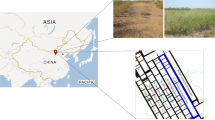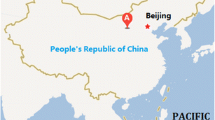Abstract
Ground cracks caused by coal mining is a typical man-made geological hazard which severely damages the ecological environment and ground structures (such as buildings, pipelines and bridges, etc.). Therefore, it is necessary to study ground crack development law in order to fully understand the mechanism of ground crack formation and to prevent damage. Current research in China is mainly focused on the mining areas in eastern China, but there have been few studies on the law and the mechanism of ground cracks caused by high-intensive mining in western China and aeolian sand areas. Additionally, the western mining areas are in an arid and semi-arid climate zone with a fragile eco-environment, where ground cracks can have a strong and irreversible destructiveness. Therefore, research on mining-induced ground cracks in western China has great practical significance. Using the mining-related ground crack in the 12,406 fully mechanized coal mining working face of the Bulianta Coal Mine in western China as an example case and performing field surveys and analyses, we determined that the dynamic ground cracks caused by high-intensive mining exhibit secondary development characteristics. The cracks have two developmental cycles and two peak values. In another words, the development law is M-shape with double peak values–double cycles, which is different from the conventional research result of “single peak value–single cycle”. In order to identify the internal mechanism of this special development law, we conducted our research from two perspectives of key strata theory and mining subsidence theory by adopting the methods of theoretical analysis and physical/numerical simulation, and then combining the results with the actual survey data of the 12,406 working face. The results indicate that the special phenomenon involving the secondary development of ground cracks meet the following conditions: (1) compound key strata exist in the covering rock (i.e., more than two layers of key strata); (2) the mining range makes the ground surface over-mined, and the flat floor is revealed in the subsidence basin; (3)the mining range achieves breaking of the span of the compound key strata, which then causes the fracture of the compound key strata. The development characteristics of mining-induced ground cracks are related to the periodic breaking of the compound key strata. The compound key strata fractures generate the tensile deformations on the secondary surface, which cause secondary ground cracks, resulting in the cracks exhibiting secondary development characteristics. The results of our study comprehensively display the internal mechanism of ground crack development, which can provide guidance in the areas of accurate ground crack prediction, land environment damage control, and ecological restoration.

























Similar content being viewed by others
References
Ayalew L, Yamagishi H, Marui H, Kanno T (2005a) Landslides in Sado Island of Japan: part I. Case studies, monitoring techniques and environmental considerations. Eng Geol 81(4):419–431
Ayalew L, Yamagishi H, Marui H, Kanno T (2005b) Landslides in Sado Island of Japan: part II. GIS-based susceptibility mapping with comparisons of results from two methods and verifications. Eng Geol 81(4):432–445
Bell FG, Genske DD (2001) The influence of subsidence attributable to coal mining on the environment, development and restoration some examples from western europe and south africa. Environmental & Engineering Geoscience 7(1):81–99
Budhu M (2008) Mechanics of earth fissures using the Mohr-coulomb failure criterion. Environmental & Engineering Geoscience 14(4):281–295
Bullock SET, Bell FG (1997) Some problems associated with past mining at a mine in the witbank coalfield, South Africa. Environ Geol 33(1):61–71
Donnelly LJ (2006) A review of coal mining induced fault reactivation in great Britain. Q J Eng Geol Hydrogeol 39(1):5–50
Donnelly LJ (2009) A review of international cases of fault reactivation during mining subsidence and fluid abstraction. Q J Eng Geol Hydrogeol 42(1):73–94
Donnelly LJ, Rees JG (2001) Tectonic and mining induced fault reactivation around barlaston on the midlands microcraton, north staffordshire, UK. Q J Eng Geol Hydrogeol 34(2):195–214
Donnelly LJ, De La Cruz H, Asmar I, Zapata O, Perez JD (2001) The monitoring and prediction of mining subsidence in the Amaga, Angelopolis, Venecia and Bolombolo regions, Antioquia, Colombia. Eng Geol 59(1–2):103–114
He G, Yang L, Ling G, Jia C, Hong D (1991) Mining subsidence science. China University of Mining and Technology Press, Xuzhou
Hu QF, Cui XM, Yuan DB, Deng XB (2012) Formation mechanism of surface cracks caused by thick seam mining and hazard analysis. Journal of Mining & Safety Engineering 29(6):864–869
Hu ZQ, X JW, A MH (2014) Distribution characteristic and development rules of ground fissures due to coal mining in windy and sandy region. J China Coal Soc 39(1):11–18
Ju JF, Xu JL (2013) Structural characteristics of key strata and strata behavior of a fully mechanized longwall face with 7.0 m height chocks. International Journal of Rock Mechanics and Mining Sciences. (58): 46–54
Kang JR (2008) Analysis of effect of fissures caused by underground mining on ground movement and deformation. Chin J Rock Mech Eng 27(1):59–64
Kratzsch H (1983) Mining subsidence Engineering. Springer, Berlin Heidelberg New York
Li X, Wang SJ, Liu TY, Ma FS (2004) Engineering geology, ground surface movement and fissures induced by underground mining in the Jinchuan nickel mine. Engineering Geology 76(1):93–107
Li X, Lu S, Liao QL, Du GD (2006) Distribution characteristics and field monitoring of ground fissures caused by backfill mining. Chin J Rock Mech Eng 25(7):1361–1369
Li L, Wu K, Hu Z, Xu Y, Zhou D (2017) Analysis of developmental features and causes of the ground cracks induced by oversized working face mining in an aeolian sand area. Environmental Earth Sciences 76(3):135
Liu H, He CG, Deng KZ, Bian Z,F, Fan HD, Lei SG, Zhang A (2013) Analysis of forming mechanism of collapsing ground fissure caused by mining. Journal of Mining & Safety Engineering 30(3):380–384
Peng SS (1992) Surface subsidence engineering. Littleton Society for Mining, Metallurgy, New York
Price DG (1995) Strategies to assess the hazards presented by abandoned room and pillar mines. In: Proc 5th Int Symp Land Subsidence. International Association of Hydrological Sciences, The Hague, pp 101–106
Qian MG, Shi PW, Xu JL (2010) Mining pressure and strata control. China University of Mining and Technology press, Xuzhou
Ratan Das, P.K. Singh, A. Kainthola, Suman Panthee, T.N. Singh (2017) Numerical analysis of surface subsidence in asymmetric parallel highway tunnels, J. Rock Mech. Geotech. Eng. doi: 10.1016/j.jrmge.2016.11.009
Sheng ZP, Helm DC, Li J (2003) Mechanisms of earth fissuring caused by groundwater withdrawal. Environmental & Engineering Geoscience 9(4):351–362
Sirdesai NN, Rajesh S, Singh TN, Ranjith PG (2015) Numerical and experimental study of strata behavior and land subsidence in an underground coal gasification project. Proceedings IAHS 92:1–8
Stacey TR, Bell FG (1999) The influence of subsidence on planning and development in Johannesburg, south africa. Environmental & Engineering Geoscience 4:373–388
Tang FQ, Zhang J (2014) Formation mechanism of cracks caused by mining in western China thick loess mine area. Journal of Liaoning Technical University (Natural Science) 33(11):1466–1470
Wang LG, Zhao EQ, Chu Y (2011) Numerical simulation of ground crack induced by steep seam mining. Journal of Harbin Institute of Technology 43[Suppl 1]:245–247
Wu K, Hu ZQ, Chang J, Ge JX (1997a) Distribution law of ground crack induced by coal mining. Journal of China University of Mining & Technology 26(2):56–59
Wu K, Zhou M, Hu ZQ (1997b) The prediction of ground fissure depth and width by mining. Journal of Fuxin Mining Institute ( Natural Science) 16(6):549–552
Xu, Y., Wu, K., Li, L., Zhou, D., & Hu, Z. (2017). Ground cracks development and characteristics of strata movement under fast excavation: a case study at Bulianta Coal Mine, China. Bull. Eng. Geol. Environ. doi: 10.1007/s10064-017-1047-y
Acknowledgments
The Natural Science Foundation of China (Grant Number U1361203) has supported the research. The authors would like to thank the editor and reviewers for their contributions on the paper.
Author information
Authors and Affiliations
Corresponding authors
Rights and permissions
About this article
Cite this article
Dawei, Z., Kan, W., Zhihui, B. et al. Formation and development mechanism of ground crack caused by coal mining: effects of overlying key strata. Bull Eng Geol Environ 78, 1025–1044 (2019). https://doi.org/10.1007/s10064-017-1108-2
Received:
Accepted:
Published:
Issue Date:
DOI: https://doi.org/10.1007/s10064-017-1108-2




